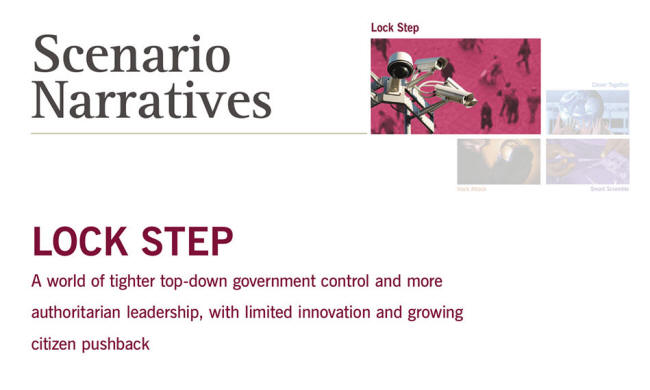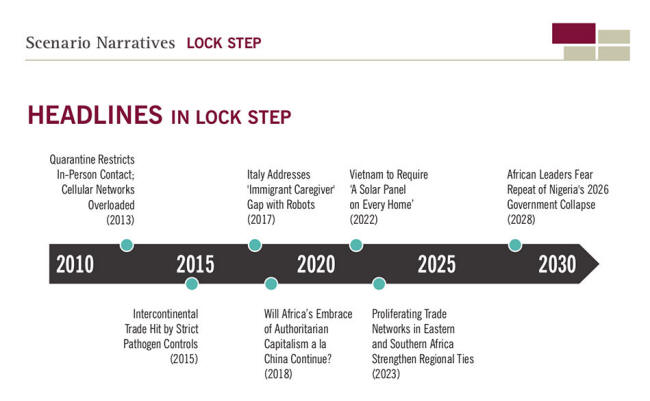|

April
18, 2020
from
TheWatchTowers Website
Base
information, sent by MJGdeA

Scenarios for
the Future of Technology
and
International Development.
This report was produced
by The
Rockefeller Foundation
and Global
Business Network,
May 2010...
Horrific...!
This evil doc written
by the
Rockefeller Globalist Foundation, gives
scenarios for bringing the world to a global one world order...
Written 10 years ago,
chronicles how to bring the world down with a pandemic...
EXCERPTS FROM
THE PAPER
LOCK STEP
A
world of tighter top-down government control
and more
authoritarian leadership,
with limited
innovation and growing citizen pushback.
In 2012, the pandemic that the world had been anticipating for
years finally hit.
Unlike 2009's
H1N1, this new influenza strain
-
originating from wild geese -
was extremely virulent and deadly.
Even the most
pandemic-prepared nations were quickly overwhelmed when the
virus streaked around the world.
"The United
State's initial policy of "strongly discouraging" citizens
from flying proved deadly in its leniency, accelerating the
spread of the virus not just within the U.S. but across
borders.
However, a few
countries did fare better - China in particular.
The Chinese
government's quick imposition and enforcement of mandatory
quarantine for all citizens, as well as its instant and
near-hermetic sealing off of all borders"
China's government was
not the only one that took extreme measures to protect its citizens
from risk and exposure.
During the pandemic,
national leaders around the world flexed their authority and imposed
airtight rules and Restrictions, from the mandatory wearing of face
masks to body-temperature checks at the entries to communal spaces
like train stations and supermarkets.
Even after the pandemic
faded, this more authoritarian control and oversight of citizens and
their activities stuck and even intensified.
In order to protect
themselves from the spread of increasingly global problems - from
pandemics and transnational terrorism to environmental crises and
rising poverty - leaders around the world took a firmer grip on
power.
At first, the notion of a more controlled world gained wide
acceptance and approval.
Citizens willingly gave
up some of their sovereignty - and their privacy - to more
paternalistic states in exchange for greater safety and stability.
Citizens were more
tolerant, and even eager, for top-down direction and oversight, and
national leaders had more latitude to impose order in the ways they
saw fit.
In developed countries,
this heightened oversight took many forms: biometric IDs for all
citizens, for example, and tighter regulation of key industries
whose stability was deemed vital to national interests.
In many developed
countries, enforced cooperation with a suite of new regulations and
agreements slowly but steadily restored both order and, importantly,
economic growth.
Across the developing world, however, the story was different - and
much more variable. Top-down authority took different forms in
different countries, hinging largely on the capacity, caliber, and
intentions of their leaders.
In countries with strong
and thoughtful leaders, citizens' overall economic status and
quality of life increased. In India, for example, air quality
drastically improved after 2016, when the government outlawed
high-emitting vehicles.
In Ghana, the
introduction of ambitious government programs to improve basic
infrastructure and ensure the availability of clean water for all
her people led to a sharp decline in water-borne diseases.
But more authoritarian
leadership worked less well - and in some cases tragically - in
countries run by irresponsible elites who used their increased power
to pursue their own interests at the expense of their citizens.
There were other downsides, as the rise of virulent nationalism
created new hazards:
By 2025, people
seemed to be growing weary of so much top-down control and
letting leaders and authorities make Choices for them.
Wherever national interests clashed with individual interests,
there was conflict.
Sporadic pushback
became increasingly organized and coordinated, as disaffected
youth and people who had seen their status and opportunities
slip away - largely in developing countries - incited civil
unrest.
In 2026, protestors
in Nigeria brought down the government, fed up with the
entrenched cronyism and corruption.
Even those who liked
the greater stability and predictability of this world began to
grow uncomfortable and constrained by so many tight rules and by
the strictness of national boundaries.
The feeling lingered
that sooner or later, something would inevitably upset the neat
order that the world's governments had worked so hard to
establish.
TECHNOLOGY IN
LOCK STEP
While there is no way of accurately predicting what the important
technological advancements will be in the future, the scenario
narratives point to areas where conditions may enable or accelerate
the development of certain kinds of technologies.
Thus for each scenario we offer a sense of the context for
technological innovation, taking into consideration the pace,
geography, and key creators.
We also suggest a few
technology trends and applications that could flourish in each
scenario.
Technological innovation in "Lock
Step" is largely driven by government and is focused on
issues of national security and health and safety.
Most technological
improvements are created by and for developed countries, shaped by
governments' dual desire to control and to monitor their citizens.
In states with poor
governance, large-scale projects that fail to progress abound.
-
Scanners using
advanced functional magnetic resonance imaging (fMRI)
technology become the norm at airports and other public
areas to detect abnormal behavior that may indicate
"antisocial intent."
-
In the aftermath
of pandemic scares, smarter packaging for food and beverages
is applied first by big companies and producers in a
business-to-business environment, and then adopted for
individual products and consumers.
-
New diagnostics
are developed to detect communicable diseases. The
application of health screening also changes; screening
becomes a prerequisite for release from a hospital or
prison, successfully slowing the spread of many diseases.
-
Tele-presence
technologies respond to the demand for less expensive,
lower-bandwidth, sophisticated communications systems for
populations whose travel is restricted.
-
Driven by
protectionism and national security concerns, nations create
their own independent, regionally defined IT networks,
mimicking China's firewalls. Governments have varying
degrees of success in policing internet traffic, but these
efforts nevertheless fracture the "World Wide" Web.
"WHAT IS OFTEN
SURPRISING ABOUT NEW TECHNOLOGIES
IS COLLATERAL
DAMAGE: THE EXTENT OF THE PROBLEM
THAT YOU CAN
CREATE BY SOLVING ANOTHER PROBLEM
IS ALWAYS A BIT
OF A SURPRISE."
Michael
Free
Program for
Appropriate Technology in Health
(PATH)

TECHNOLOGY IN
'CLEVER TOGETHER'
In "Clever
Together," strong global cooperation on a range of issues
drives technological breakthroughs that combat disease, climate
change, and energy shortages.
Trade and foreign direct
investment spread technologies in all directions and make products
cheaper for people in the developing world, thereby widening access
to a range of technologies.
The atmosphere of
cooperation and transparency allows states and regions to glean
insights from massive datasets to vastly improve the management and
allocation of financial and environmental resources.
Technology trends and applications we might see:
-
Intelligent
electricity, water distribution, and transportation systems
develop in urban areas. In these "smart cities," internet
access is seen as a basic right by the late 2010s.
-
A malaria vaccine
is developed and deployed broadly - saving millions of lives
in the developing world.
-
Advances in
low-cost mind-controlled prosthetics aid the 80 percent of
global amputees who live in developing countries.
-
Solar power is
made vastly more efficient through advances in materials,
including polymers and nanoparticles. An effective
combination of government subsidies and microfinance means
solar is used for everything from desalination for
agriculture to Wi-Fi networks.
-
Flexible and
rapid mobile payment systems drive dynamic economic growth
in the developing world, while the developed world is
hampered by entrenched banking interests and regulation.
There is much more in the original paper "Rockefeller
Foundation Scenarios for the Future of Technology and International
Development".
Video
President of Ghana, Nana Akufo Addo
Reads
Rockefeller's Plans...
|



